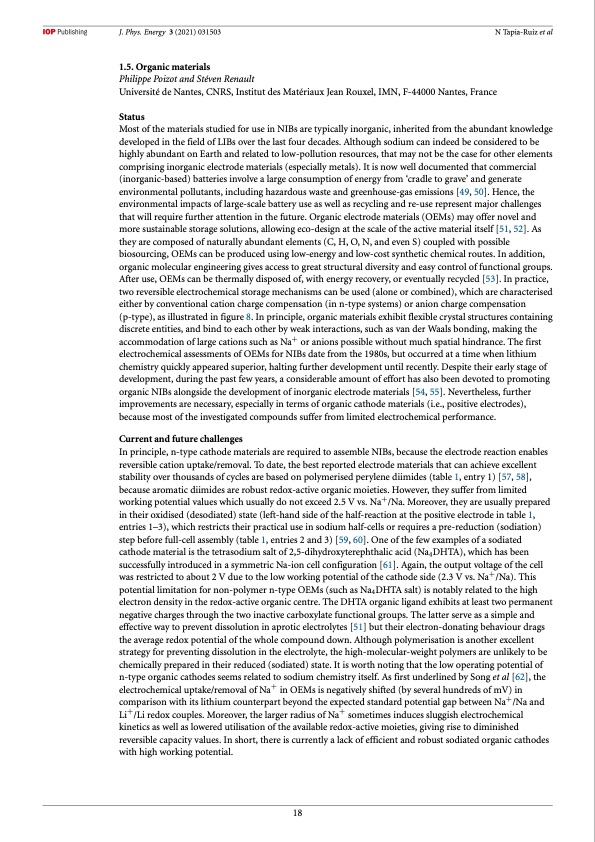
PDF Publication Title:
Text from PDF Page: 019
J. Phys. Energy 3 (2021) 031503 N Tapia-Ruiz et al 1.5. Organic materials Philippe Poizot and Stéven Renault Université de Nantes, CNRS, Institut des Matériaux Jean Rouxel, IMN, F-44000 Nantes, France Status Most of the materials studied for use in NIBs are typically inorganic, inherited from the abundant knowledge developed in the field of LIBs over the last four decades. Although sodium can indeed be considered to be highly abundant on Earth and related to low-pollution resources, that may not be the case for other elements comprising inorganic electrode materials (especially metals). It is now well documented that commercial (inorganic-based) batteries involve a large consumption of energy from ‘cradle to grave’ and generate environmental pollutants, including hazardous waste and greenhouse-gas emissions [49, 50]. Hence, the environmental impacts of large-scale battery use as well as recycling and re-use represent major challenges that will require further attention in the future. Organic electrode materials (OEMs) may offer novel and more sustainable storage solutions, allowing eco-design at the scale of the active material itself [51, 52]. As they are composed of naturally abundant elements (C, H, O, N, and even S) coupled with possible biosourcing, OEMs can be produced using low-energy and low-cost synthetic chemical routes. In addition, organic molecular engineering gives access to great structural diversity and easy control of functional groups. After use, OEMs can be thermally disposed of, with energy recovery, or eventually recycled [53]. In practice, two reversible electrochemical storage mechanisms can be used (alone or combined), which are characterised either by conventional cation charge compensation (in n-type systems) or anion charge compensation (p-type), as illustrated in figure 8. In principle, organic materials exhibit flexible crystal structures containing discrete entities, and bind to each other by weak interactions, such as van der Waals bonding, making the accommodation of large cations such as Na+ or anions possible without much spatial hindrance. The first electrochemical assessments of OEMs for NIBs date from the 1980s, but occurred at a time when lithium chemistry quickly appeared superior, halting further development until recently. Despite their early stage of development, during the past few years, a considerable amount of effort has also been devoted to promoting organic NIBs alongside the development of inorganic electrode materials [54, 55]. Nevertheless, further improvements are necessary, especially in terms of organic cathode materials (i.e., positive electrodes), because most of the investigated compounds suffer from limited electrochemical performance. Current and future challenges In principle, n-type cathode materials are required to assemble NIBs, because the electrode reaction enables reversible cation uptake/removal. To date, the best reported electrode materials that can achieve excellent stability over thousands of cycles are based on polymerised perylene diimides (table 1, entry 1) [57, 58], because aromatic diimides are robust redox-active organic moieties. However, they suffer from limited working potential values which usually do not exceed 2.5 V vs. Na+/Na. Moreover, they are usually prepared in their oxidised (desodiated) state (left-hand side of the half-reaction at the positive electrode in table 1, entries 1–3), which restricts their practical use in sodium half-cells or requires a pre-reduction (sodiation) step before full-cell assembly (table 1, entries 2 and 3) [59, 60]. One of the few examples of a sodiated cathode material is the tetrasodium salt of 2,5-dihydroxyterephthalic acid (Na4DHTA), which has been successfully introduced in a symmetric Na-ion cell configuration [61]. Again, the output voltage of the cell was restricted to about 2 V due to the low working potential of the cathode side (2.3 V vs. Na+/Na). This potential limitation for non-polymer n-type OEMs (such as Na4DHTA salt) is notably related to the high electron density in the redox-active organic centre. The DHTA organic ligand exhibits at least two permanent negative charges through the two inactive carboxylate functional groups. The latter serve as a simple and effective way to prevent dissolution in aprotic electrolytes [51] but their electron-donating behaviour drags the average redox potential of the whole compound down. Although polymerisation is another excellent strategy for preventing dissolution in the electrolyte, the high-molecular-weight polymers are unlikely to be chemically prepared in their reduced (sodiated) state. It is worth noting that the low operating potential of n-type organic cathodes seems related to sodium chemistry itself. As first underlined by Song et al [62], the electrochemical uptake/removal of Na+ in OEMs is negatively shifted (by several hundreds of mV) in comparison with its lithium counterpart beyond the expected standard potential gap between Na+/Na and Li+/Li redox couples. Moreover, the larger radius of Na+ sometimes induces sluggish electrochemical kinetics as well as lowered utilisation of the available redox-active moieties, giving rise to diminished reversible capacity values. In short, there is currently a lack of efficient and robust sodiated organic cathodes with high working potential. 18PDF Image | 2021 roadmap for sodium-ion batteries

PDF Search Title:
2021 roadmap for sodium-ion batteriesOriginal File Name Searched:
roadmap-sodium-ion-batteries_031503.pdfDIY PDF Search: Google It | Yahoo | Bing
Salgenx Redox Flow Battery Technology: Salt water flow battery technology with low cost and great energy density that can be used for power storage and thermal storage. Let us de-risk your production using our license. Our aqueous flow battery is less cost than Tesla Megapack and available faster. Redox flow battery. No membrane needed like with Vanadium, or Bromine. Salgenx flow battery
| CONTACT TEL: 608-238-6001 Email: greg@salgenx.com | RSS | AMP |